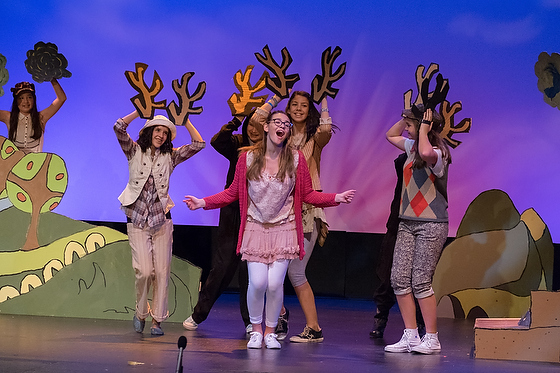 |
| Fujifilm X-E2, FUJINON XF 55-200mm, ISO 6400, ƒ/5, 1/300 |
The quality of the images is great for shooting theater, which is a real bonus since my daughter is loving theater. She is the witch in the Georgia Ensemble Theatre Conservatory play this summer Shrek The Musical JR.
 |
| Fujifilm X-E2, FUJINON XF 55-200mm, ISO 6400, ƒ/5, 1/320 |
 |
| Fujifilm X-E2, FUJINON XF 55-200mm, ISO 5000, ƒ/4.8, 1/500 |
The other thing that helps the sharpness of the photos is LMO.
The advanced Lens Modulation Optimizer (LMO) technology in the FUJIFILM X-E2 was made possible by the integrated development of the lens, sensor and processor. For each mounted lens, LMO high-precision processing of the lens focal length and aperture, as well as data from the screen center to the edges, corrects diffraction blur when shooting with a stopped down aperture and compensates for the slight blurring in the lens periphery. The result is edge-to-edge image quality with incredible sharpness and a sense of dimensional reality.
 |
| Fujifilm X-E2, FUJINON XF 55-200mm, ISO 5000, ƒ/4.8, 1/480 |
 |
| Fujifilm X-E2, FUJINON XF 55-200mm, ISO 6400, ƒ/4.5, 1/480 |
 |
| Nikon D750, AF-S NIKKOR 28-300mm f/3.5-5.6G ED VR,, ISO 4500, ƒ/5.6, 1/250 |
Just a minute later with the Fuji System
 |
| Fujifilm X-E2, FUJINON XF 55-200mm, ISO 6400, ƒ/4, 1/420 |
First of all the slower AF-S NIKKOR 28-300mm f/3.5-5.6G ED VR compared to the FUJINON XF 55-200mm f/3.5-4.8 R LM OIS Lens made it possible to shoot at 1/420 vs 1/250. Then the comparison of the bodies is the mirrorless didn't have the mirror to add vibration.
However the plus side of the Nikon is more lens choices than the Fujifilm system. I preferred the lens range of 28-300mm to the 55-200mm.
Going back for the second performance and will see if I have any more thoughts for a post on Monday.




No comments:
Post a Comment